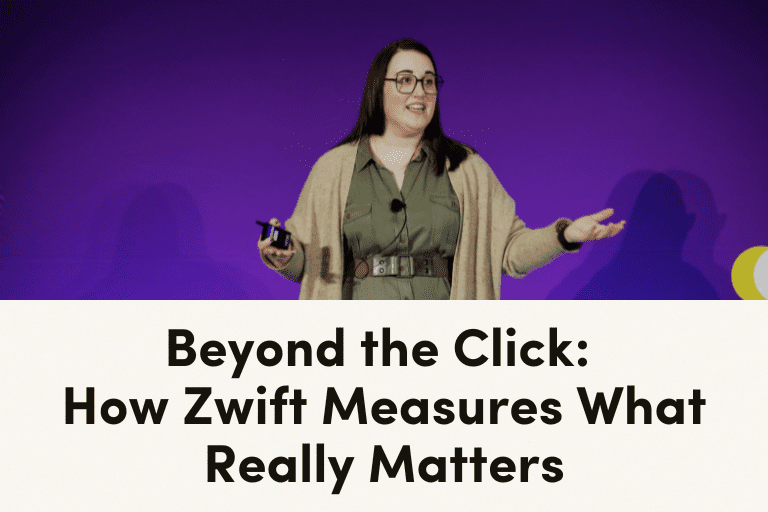Vanity metrics, like open rates and single-touch attribution, had their moment. But in 2025, they’re a dead end. Not only do they flatten the complexity of the customer journey and give outsized credit to the last thing a person clicked, but they also overlook the dozens of touchpoints that actually built momentum.
For marketers on the hook to prove impact to the C-suite, that’s a problem. You can’t defend your budget or your team’s value on incomplete metrics that don’t tie to real business outcomes.
At Zwift, the world’s leading indoor cycling app, we didn’t settle. At the 2025 Activate Summit, I shared how our team has thrown out the “good enough” playbook and replaced it with something better: incrementality.
Backed by rigorous experimentation, a focus on downstream business impact, and sharp operational efficiency, we have developed a measurement framework that earns stakeholder trust and drives lasting growth.
Opens Are Dead—These Are the Metrics That Matter
Privacy changes, such as Apple’s Mail Privacy Protection, Gmail link prefetching, and antivirus link scanning, have turned open rates and clicks into a minefield of false positives. For Zwift—where close to 75% of users are on Apple devices—those numbers no longer signal genuine interest.
That doesn’t mean tossing them entirely. Zwift now treats opens and clicks as channel health metrics—grouped with deliverability, unsubscribes, and uninstalls. They’re useful for spotting whether a channel is still trusted and functional. But they aren’t proof of campaign success. A healthy channel can still deliver flat engagement and zero conversions.
The same goes for attribution. Last-touch models give all the glory to the final visible interaction, ignoring the multi-touch nurturing that actually led to the win. And standard conversion tracking? It stops at the transaction and misses the deeper story. Repeat engagement, lifetime value (LTV), and reduced churn are the metrics that matter most for long-term growth.
Embrace Incrementality: The New Plan of Attack
Your customers are everywhere. They’re scrolling social, swiping in your app, watching live broadcasts, and receiving push alerts. With so many touchpoints in play, guessing which one actually drove action isn’t just risky—it’s wrong.
That’s where incrementality comes in. For marketers, it’s the scientific standard for proving cause and effect. By running controlled experiments, you strip away the noise and see exactly what’s working. One group gets the campaign. The other doesn’t. Everything else stays the same. If there’s a lift, you know it’s because of that message or channel, not a lucky coincidence.
With Iterable’s Experiments, Zwift can spin up these tests fast, run them at scale, and get answers that stick.
“We’re making the assumption scientifically that everyone in the send group and everyone in the control group has an equal opportunity of seeing anything else that’s out there, of seeing our social media, of seeing our game advertising, of seeing our paid media ads. And so you’re exposed to all the same things. And the only thing that’s different is this push notification.”
~ Rachel Kamel, Director of CRM at Zwift
And when the results land, they hit hard. After the 2024 Tour de France Femmes avec Zwift, a single push inviting riders to join champion Kasia Niewiadoma for a virtual ride resulted in an 82% increase in sign-ups compared to the control. That’s not a hunch. That’s proof, and proof wins in the boardroom.
Measure the Downstream Business Impact
Once marketers move beyond vanity metrics, the challenge becomes linking marketing efforts to business performance. Zwift’s framework uses a hierarchy that starts with basic engagement indicators, progresses to high-value actions, and culminates in business KPIs.
At the base are channel engagement metrics, which provide insight into whether communication channels are viable and maintain audience trust:
- Deliverability
- Unsubscribes
- Uninstalls
Next are high-value actions, which are more closely tied to customer intent and product engagement. These include:
- Event registrations
- New feature adoption
- App downloads
Finally, at the top of the hierarchy are core business KPIs, which represent overall organizational performance and growth:
- Subscription renewals
- Revenue growth
- Monthly and daily active users
- Increases in LTV
- Reductions in churn
Rather than evaluating a campaign only by its stated goal, Zwift examines its ripple effects across all three tiers. For example, a push about a new in-game event might not only drive participation, but also spark interest in upgraded equipment or inspire lapsed subscribers to return. These are measurable, bottom-line outcomes that executives recognize as meaningful wins.
Channel expansion is another way Zwift uses metrics to demonstrate business impact. By adding push notifications to the mix, our owned audience reach increased by 3% in just one month, capturing customers who were previously unreachable through email alone.
|
Channel Engagement |
High-Value Actions |
Core Business KPIs |
|
Deliverability Unsubscribes Uninstalls |
Event registrations New feature adoption App downloads |
Subscription renewals Revenue growth Monthly and daily active users Increases in LTV Reductions in churn |
Win With Operational Success
Metrics also play a role in proving operational efficiency, a critical factor for small marketing teams. For Zwift, incorporating push notifications into the channel mix was a game-changer. Push campaigns are faster to produce than fully localized HTML emails, requiring less design and translation work while still delivering timely, personalized content.
In under six months, the team supported more than 60 event-related campaigns via push, a volume that would have been impossible to achieve through email alone. Production time dropped by 85%, freeing the team to focus on strategy, creative experimentation, and cross-channel alignment.
Operational success metrics like these are more than internal talking points. They shape budget discussions, hiring plans, and platform investments. They demonstrate that the team isn’t just generating revenue but also working smarter, delivering more output without proportionally increasing costs.
How Marketers Cross the Finish Line
Marketers have spent years defending results with shaky indicators. But with privacy rules tightening, platforms shifting, and customer journeys splintering across channels, one thing is certain: legacy metrics can’t tell the whole story.
Zwift’s measurement strategy proves there’s a better way. Ditch the obsession with opens and clicks. Use incrementality to nail down true cause and effect. Tie every campaign to the metrics that actually move the business: revenue, LTV, and churn reduction. And don’t overlook operational efficiency—demonstrating that you can achieve more with less is its own kind of ROI.
|
Marketing ROI can be difficult to calculate—which is why Iterable’s here to help. Try out our Value Calculator to receive a customized business case with projected growth and efficiency results for your company, based on real results from 1,000+ Iterable customers like Zwift. |
Today’s marketing winners are the ones who leverage tools like Iterable to make experimentation a habit, measure what matters, and secure those quick wins. Just like in fitness, it’s all about progress over perfection. Collaborate with your team to measure non-campaign metrics and demonstrate program success, ultimately crossing the finish line together.
For the full playbook straight from Zwift’s CRM team, watch the full session recording here.
| Want to take your deliverability to the next level? Download Email Deliverability 101: How to Reach the Inbox Every Time—your complete guide to building trust, boosting engagement, and ensuring your messages land where they belong. |
































